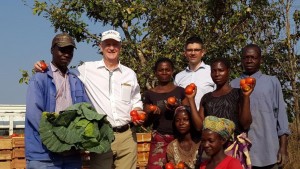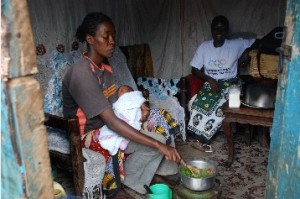Postharvest loss = Nutrition loss
By Roberta Lauretti-Bernhard, Senior Technical Advisor GAIN-Global Alliance for Improved Nutrition
This post is part of the ADM Institute’s #PreventPHL blog campaign, following up on the First International Congress on Postharvest Loss Prevention. To read more posts in the series, click here.
One-third of the food produced globally is lost or wasted.
It is a well-known fact that post-harvest loss and waste (PHL/W) contributes to environmental degradation and economic losses, including over $750 billion in food sales. Postharvest losses are also nutrient losses, which negatively impacts food security and contributes to 2-3% forfeiture in GDP from nutrition-related decrease in human productivity.[i]
Improving production is important to increasing the availability of nutritious foods; but it is more efficient to utilize the food already produced than convertiThe ng more land into production, applying more fertilizers, raising more livestock, and increasing energy use for producing, processing, transporting, and storing more food. Meta data analysis shows that 50% of fruits and vegetables produced in Sub-Saharan Africa are lost or wasted.[ii]
Fruits and vegetables are some of the most perishable crops and they are nutrient powerhouses; packed full of vital micronutrients and can improve nutrient absorption in a diet high in phytate (from whole grains, seeds, pulses).[iii]
Reducing PHL/W along all segments of fruit and vegetable value chains presents an opportunity to improve nutrition security by capturing otherwise lost nutrients to channel into the food system and create profitable, accessible and affordable diversified diets.
“A Mango a Day supplies Vitamin A”
Mango is a common fruit consumed by all population quintiles in Sub-Saharan Africa. Mangos contain high levels of pro-Vitamin A, a crucial nutrient to the cognitive development of children. In 2014, Kenya produced 181,567 MTs of mangoes, of which over 81,567 MTs were lost, never reaching the consumer. If we could reduce the PHL/W of mangoes by just 25–35% and channel those lost nutrients into the Kenyan food system, we could provide over 85,000 – 120,000 malnourished children with their estimated average requirement (EAR) of pro-Vitamin A every day for a year.
GAIN – Bridging the Gap between Agriculture and Nutrition
The Global Alliance for Improved Nutrition (GAIN) is an international organization whose mission is to reduce global malnutrition. Around 3.5 billion people — half the people on the planet today — are malnourished. Each year, malnutrition kills 3.1 million children under the age of five and leaves 161 million [iv] stunted, trapping generations in lives of poverty and unfulfilled potential. GAIN’s global programs; Large Scale Food Fortification, Business Partnerships in Nutrition, Maternal, Infant and Young Child Nutrition and Agriculture for Nutrition, build alliances through research and technical solutions to end malnutrition.
While many research and assistance programs seek to improve food supply chains in developing countries, they largely focus on staple food commodities with high economic value and rely on income-generating pathways to improve nutrition among participating households. Technical assistance interventions primarily concentrate efforts “on-farm” to increase agricultural production and improve productivity. This method assumes that by increasing incomes and primary food supplies, beneficiary households will use the additional food and income to improve their families’ diet. It also assumes that value chain efficiencies exist, allowing markets to provide more nutritiously dense food products with easy consumer access and affordable price points. While addressing the challenges on-farm is a necessary step, it is only one of the many key elements to a holistic approach to reduce PHL/W. GAIN’s “Agriculture for Nutrition” (AgNut) initiative forms alliances with all the actors and stakeholders to reduce inefficiencies in the agricultural value chain and identify opportunities for nutrition interventions at each stage – from the farm gate to storage, processing to distribution, retail, marketing and food preparation. Our goal is to build an enabling environment for private sector development and investment in agriculture and nutrition. GAIN’s ethnographic nutrition studies have proven that while small-scale farm families and urban poor often produce crops & livestock, they rely on markets for their primary food needs; from small local kiosks to large national grocery chains. To date, GAIN’s “Marketplace for Nutritious Foods” program in Kenya, Tanzania, and Mozambique has delivered more than 6 million servings of nutritious foods.
The Market Place has provided valuable insights into the supply chain issues and with the growing global efforts to reduce PHLW, GAIN’s AgNut team is setting their sights on the issue and the implications it has for nutrition and economic development by launching a new program in early 2016.
[i] World Bank. (2015). Nutrition Overview: Context. Retrieved from http://siteresources.worldbank.org/NUTRITION/Resources/281846-1131636806329/NutritionStrategyCh1.pdf
[ii] FAO Statistical Yearbook, 2009
[iii] http://horticulture.ucdavis.edu/main/media%20page/FS_Hort_Nutrition_Strategy_small.pdf
[iv] WHO: Global Health Observatory (2011) ‘Child Health’, Geneva: World Health Organization, http://www.who.int/gho/child_health/en/ [last accessed 16 April 2012].
The blog entries in this #PreventPHL series are by students and members of the PHL Prevention community of practice. The opinions expressed are those of the individual authors and do not necessarily reflect the position of the ADM Institute. In addition, none of the statements should be considered an endorsement of any person, product, or technique by the ADM Institute.





1 Comment
Thank you Roberta Lauretti-Bernhard and GAIN for the “Postharvest loss = Nutrition loss” post,
Etharen Cousins (2013)the Executive Director of the UN WFP says
“tackling [staple grain] post-harvest loss is not rocket science. It does not require technological breakthroughs or years of high level scientific research as do some of the other challenges we face.”
Would carefully weighing assumptions that “high value” is only economic and not caloric, help answer why PHL is not already tackled?
Phytate staple grains are of high value to SSA human productivity because calories accomplish the physical labor needed to grow and harvest food.
Is it possible that
– now high value calories are more limiting to SSA human productivity than the dense nutrition from fruits and vegetables
– “densely nutritious” lacks meaning now because SSA staple grains contain significant Aflatoxin
– removing Aflatoxin from the food supply chain would enable export based GDP to decouple PHL from land degradation sooner than later?
Finally, technical assistance interventions primarily concentrate efforts “onfarm” because as Dr. Cardwell (2015) National Program Leader, National Institute of Food and Agriculture, USDA states
“Farmers whose scale of operation is too small to be able to produce SAFE FOOD, are too small to farm maize (or any aflatoxin sensitive staple).”
Thank you ADMI for the chance to comment,
William Lanier
NeverIdle Farms Consulting
Reference
Cardwell, K. (2015, April). Aflatoxin Identifying the Way Forward [TOPS Presentation].
Retrieved .
Add Comment